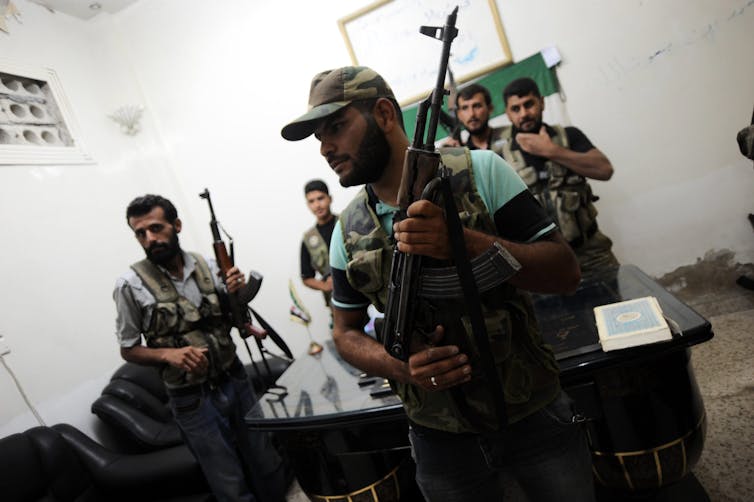Political upheaval within the Syrian National Council (SNC) is worsening the chaos that has defined Syria for the past two years. In recent times, we’ve also seen allegations of chemical weapon use and the increasing dominance of jihadist groups to add further tumult to a nation still gripped by civil war.
The resignation of opposition leader Moaz al-Khatib from the SNC last month further exposed the organisation’s political instability. The SNC remains far removed from the reality on the ground, where some analysts estimate over a thousand separate groups are waging war on the Ba’ath regime.
At the apparent helm of the SNC now sits Ghassan Hitto. Although, given Khatib’s leading role at the Arab League conference in Doha last month, even this is in doubt. An outsider technocrat who has spent the majority of his life living in the United States, Hitto has already stated his opposition to engage in dialogue with the Assad regime.
Whereas Khatib could at least claim a veneer of legitimacy through recognition from the secular elements of the rebel forces, Hitto has already been seen to be politically divisive and lacking in authority.
Unlike in Libya, where opposition groups were able to assemble a coherent political alternative to the Gaddafi regime, Syrian rebels have been thus far incapable of presenting a consolidated and unified front. The clear divisions within the SNC itself - as well as between secular and Islamist groups - only serve to make potential backers hesitant to lend major assistance.
At the same time international players have failed to enforce the same redlines that were set in Libya. Threats by Gaddafi to lay waste to Benghazi were cited by the US and its allies as clear justification for intervention. Yet Syrian president Bashar al-Assad has flagrantly reduced much of Syria to an image reminiscent of a mid-1990s Grozny with little repercussion.
While the use of warplanes quickly brought about a NATO-enforced no-fly zone that saw Libyan skies free of fighter aircraft, heavy aerial bombing has become a daily occurrence in many of the major Syrian population centres with only muted protests from Western governments.
Even more concerning was a March 19 explosion in Aleppo, which left 25 people dead. This may represent the first use of chemical weapons in the Syrian civil war. Allegations of responsibility have been made at both sides, but given the relatively small number of casualties, the suggestion that many of those killed were loyalists, and the clear lack of strategic interest in using chemical weapons, regime responsibility remains contentious.
Although Secretary General Ban Ki-moon has authorised a UN investigation into the matter, that the UN is currently evacuating half its Syrian staff from the Damascus Sheraton (including special envoy Lakhdar Brahimi) doesn’t bode well for a serious forensic investigation in the northern warzone.
Adding fuel to the speculation is the fact that a chlorine plant within 25km of Aleppo has been in rebel hands for months. There is also the suggestion by some senior UN military officials that the device was a rudimentary “dirty bomb” with an attached chemical payload, rather than a high-lethality military munition.
These claims of chemical use, combined with the increasingly prominent role being played by radical jihadist groups like Jabhat al-Nusra and Ahrar al-Sham inside Syria, may be playing a part in rousing a limited amount of discernible action from the West.

Despite the establishment of US and French training camps for the secular Free Syrian Army personnel in neighbouring Jordan, the Islamists continue to display an efficacy unsurpassed by their nationalistic contemporaries. Responsible for over 75% of suicide attacks in the war to date, al-Nusra has been of particular concern to many Syria watchers due to its links with al-Qaeda and its professed end-game objective of establishing a theocratic state that disregards the current borders of the region.
While the Free Syria Army has withered after two sustained years of fighting with limited support, jihadists have been able to prosper via links with Gulf states - like Saudi Arabia and Qatar - who have a vested interest in proxying such groups against their enemies and a historical strategic tendencies towards just that.
As the tug-of-war between regime and rebel forces continues to devastate the Levant region, the likelihood of a near-term resolution to the war has been extinguished. Whispers throughout the corridors of the UN general secretariat in New York are now predicting a protracted and “Balkanised” struggle lasting years.
Although the conflict may once have been about personalities, its increasingly sectarian nature from jihadist influence indicates that even if Assad were to be ousted or killed, the drivers for mass violence would remain. Should the Assad regime somehow cease to be a factor in the equation, the aftermath would likely see a repeat of post-war Chechnya or Afghanistan, with secular, moderate and radical groups turning on each other to fight over the scraps in the rubble.
Interventionists will continue to appeal for some form of multilateral resolution to the crisis. However, the reality seems to suggest it would be the international relations’ equivalent of sticking one’s hand into a flaming blender full of bees just to stymie the blades.

